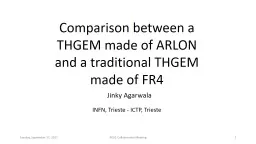

RD51 Collaboration Meeting 1 INFN Trieste ICTP Trieste Jinky Agarwala Tuesday September 27 2017 RD51 Collaboration Meeting 2 ARLON and FR4 THGEMs Set up and conditions of the measurements ID: 811376
Download The PPT/PDF document "Comparison between a THGEM made of ARLON..." is the property of its rightful owner. Permission is granted to download and print the materials on this web site for personal, non-commercial use only, and to display it on your personal computer provided you do not modify the materials and that you retain all copyright notices contained in the materials. By downloading content from our website, you accept the terms of this agreement.
Slide1
Comparison between a THGEM made of ARLON and a traditional THGEM made of FR4
RD51 Collaboration Meeting
1
INFN, Trieste - ICTP, Trieste
Jinky Agarwala
Tuesday, September 27, 2017
Slide2RD51 Collaboration Meeting
2
ARLON and FR4 THGEMs
Set up and conditions of the measurements
Comparison of resultsEffect of x-ray illumination
Previous characterization of a THGEM made of
Permaglass
Conclusions
Outlines
Tuesday, September 27, 2017
Slide3RD51 Collaboration Meeting
3
ARLON and FR4
THGEMs
Area: (300 x 300) sq. mm Thickness of the piece: 0.4 mm
Pitch: 0.8 mm Hole diameter: 0.4 mm No Rim
ARLON 25
FR Dielectric constant: 3.58Ceramic-filled fiberglass material
Fiberglass FR4
Dielectric constant: 4.7
Woven fiberglass and epoxy resin
Tuesday, September 27, 2017
Both produced by ELTOS
Slide4RD51 Collaboration Meeting
4
The Readout Pads (Anode):
24 x 24 matrix Divided into 18 regions
Each region has 32 (4 x 8) pads read together
Gas Used:
Ar:CO
2
= 70:30HVPS
: CAEN N1471HSoftware for HVPS: GECO 2020PreAmplifier:
CREMAT 110
Amplifier:
Ortec
672
MCA:
AMPTEK 8000A
Source:
55
Fe (5.9 keV)
Rate: 5 kHz
Tuesday, September 27, 2017
Multi-Pad Anode (12mm X 12mm)
Thickness: 0.4 mm
KAPTON
Drift
17.5 mm
2.5 mm
Slide5Tuesday, September 27, 2017
RD51 Collaboration Meeting
5
Measurements: Drift Scans and Induction Scans
Similar responses
Slide6Tuesday, September 27, 2017
RD51 Collaboration Meeting
6
Effective Gain
Very similar effective gains
Vc
889 V
|
Ec
|
22.2
kV/cm
Δ
V
10
178 V
|Δ
E
10
|
4.45
kV/cm
Vc
902
V
|
Ec
|
22.6
kV/cm
Δ
V
10
192
V
|Δ
E
10
|
4.8
kV/cm
ARLON
FR4
E_Ind
= 2kV/cm, E_D= 0.8 kV/cm
Slide7RD51 Collaboration Meeting
7
Energy Resolution
Calibration factor:1.048228
231 electrons per channel,
27 channels/
fC
Tuesday, September 27, 2017
Energy Resolution: 11.9 %
ARLON
FR4
Energy Resolution: 12.2 %
They have the same Energy Resolution
Slide8Tuesday, September 27, 2017
RD51 Collaboration Meeting
8
Effective gain variation with time
ARLON
FR4
8 h
60 h
Gain variations with time for the two pieces are not the same
Slide9Tuesday, September 27, 2017
RD51 Collaboration Meeting
9
Correlation between effective gain and P/T
Correction Factor (C): 1+0.00151X{(P/T)-(P_0/T_0)}
Correction is applied if: 0.01 < |1-C| < 0.001
This recipe is used by COMPASS RICH-1 hybrid detectors
Labview
HV control program with P, T corrections
HV bias modified to compensate for P and T variations
Slide10RD51 Collaboration Meeting
10
Gain stabilization with HV corrections
Tuesday, September 27, 2017
Variation within +(-) 2.5%
Slide11Tuesday, September 27, 2017
RD51 Collaboration Meeting
11
Gain Uniformity
ARLON
FR4
σ
= 9.1 %
σ
= 16.1 %
Slide1212
Effect of illumination by
55
Fe source
Broadening of the spectra
Uniformity scan performed after A6 was illuminated for 5 hours
Uniformity scan performed after A4 was illuminated for 67 hours
Slide13Tuesday, September 27, 2017
RD51 Collaboration Meeting
13
Long term persistence of the illumination effect on ARLON and FR4
08-Sept 11-Sept 13-Sept 15-Sept 18-Sept10 DAYS
26-Jun 21-July 24-July 01-Aug 09-Aug 06-Sept 08-Sept
70 DAYS
ARLON
FR4
Slide14Tuesday, September 27, 2017
RD51 Collaboration Meeting
14
The responses of identical THGEMs made of ARLON and FR4 have been compared
The gain and the energy resolution are the sameThe charging up is faster in FR4
The recovery from the illumination effect is much slower in ARLON
The ARLON material is not suitable for high rate THGEM application
Conclusions
Slide15About PERMAGLAS
Permaglas
ME730 by
RESARM Engineering Plastics SA
Epoxy glass fibre material, amorphous, machinable
The plate planarity is obtained by machining
Purchased by us:
Slide16THICKNESS UNIFORMITY
Raw material characterization
Nominal thickness 0.7 mm
/D/ < 4%; s < 2%Nominal thickness
1 mm/D/ < 2%;
s
<
1%
Very good thickness uniformity!
Cu layers glued at CERN by
Rui
de Oliveira
Drilling performed by ELTOS
Slide17ELECTROSTATIC PROPERTIES
PASCHEN test for 1mm thick piece
90% PASCHEN limit
Slide18RESULTS
UNIFORMITY SCAN:
s: 13%
ENERGY RESOLUTION:20 %
GAIN PERFORMANCE:A robust device
Gas:
Ar:CO
2
= 70:30
Source:
55
Fe
Slide19TIME DEPENDENT EFFECTS
CHARGING UP STUDIES
Effect of the ion motion in the material
Slide20CONCLUSIONS about PERMAGLAS THGEM
Robust material with good uniformity performance
Difficult to get good quality thin foils
Limited gain dependence on rate (charging up) and time (ion displacement in the bulk dielectric)
Slide21Tuesday, September 27, 2017
RD51 Collaboration Meeting
21
Thank You